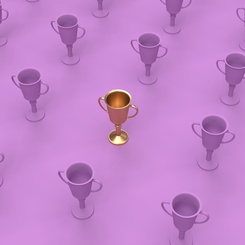With ESSEC Knowledge Editor-in-chief
Why do some TED talks go viral - and others flop? Amir Sepehri, assistant professor of marketing at ESSEC Business School, Dr. Rod Duclos (Western University) and Nasir Haghighi (University of Washington at Tacoma) found that it comes down to the amount of information contained in a talk. When a talk is chock full of content, broaching several topics, we tend to get information overload, leading us to disengage from the video. So how can communicators make sure their message gets heard and their audience clicks with the video?
Past research on cultural products (i.e., songs, books, movies, etc.) suggests that content popularity is harder to predict than one might expect (e.g., Salganik et al., 2006). While social influence plays a role - meaning that popular content will get more attention, and less popular content will fade away - identifying the type of content that becomes popular is unpredictable.
Information (over)load
To see how we can refine our predictions on cultural markets, the researchers explored the role of information load in an article recently published in The Journal of Personality and Social Psychology. In this context, this refers to the number of topics covered in one talk. If the talk lasts 10 minutes, jumping from biology to environmental science to ethics to philosophy, this wealth of information may seem useful and enriching - but makes the presentation harder to process than one of the same length covering only biology and environmental science. Put simply, our brains have an easier time processing information when, well, there’s less to process!
When we can process information more easily, we pay more attention, and our interest is piqued. This means the reverse is also true: too much information tends to overwhelm us, making it harder to process. When we consume information for pleasure and entertainment, we’re often seeking out information that won’t prove too challenging to our brains.
To explore the link between information overload and TED talk popularity, the researchers conducted a series of studies. In these studies, participants watched snippets of TED talks, and were then asked about their opinions on the TED talks, including their interest level and how much they liked the video. The research team also analyzed the entire repertoire of TED talks available online using Natural Language Processing (NLP) methods, analyzing the link between the number of topics covered in a single talk and the number of views it received.
Information overload, interest on hold
It turns out that videos that covered more topics were less catchy for viewers. While those creators likely aimed to provide an enriching experience for their audience, they instead buried them in information - simultaneously burying their popularity. Why? Satisfied viewers were also more likely to like and share the content and social media, leading to even more views in a virtuous cycle. This is despite the fact that their study showed that audiences are more likely to initially click on a talk covering many different topics. Even when people thought they would prefer these informative videos, they tended to prefer the simpler ones that were simpler to process.
There’s a catch: certain people are less susceptible to this information overload, namely
audience members who are watching the video for educational and cognitive purposes rather than purely for entertainment. The results suggest that in the end, when it comes to information overload, more isn’t always better—especially when the audience isn’t really interested in thinking too hard.
Key takeaways
-
Jack of all trades, master of none: Speakers should focus on keeping it simple and going in-depth on only a handful of topics, rather than trying to cover all the bases.
-
Know your audience: if your viewers are watching your content to learn something, you can get away with more information-rich content. Otherwise, get to the point!
-
Pick your poison: If your message must cover a significant amount of topics, consider using a written medium rather than a visual one to reduce the risk of overwhelming your viewers.
-
Know thyself: for individuals consuming content, think about your goal. Are you looking to learn something new, or for entertainment? Consider your choice of content in light of this to make the most of it!
Taken together, this study has implications not only for professionals seeking to maximize their impact, but also for individuals who want to boost their enjoyment of culture and entertainment.
This research was funded by a CERESSEC grant and by an Ivey Research Policy grant.
Reference
Salganik, M. J., Dodds, P. S., & Watts, D. J. (2006). Experimental study of inequality and unpredictability in an artificial cultural market. Science (New York, N.Y.), 311(5762), 854–856. https://doi.org/10.1126/science.1121066









